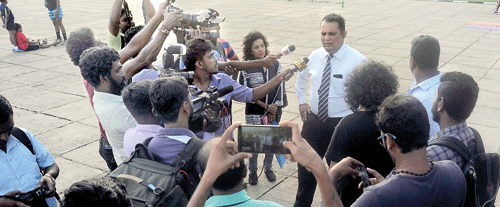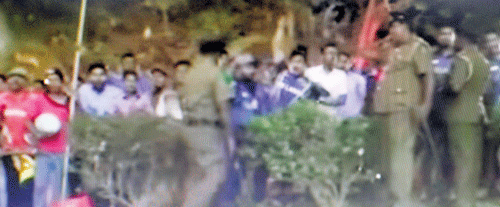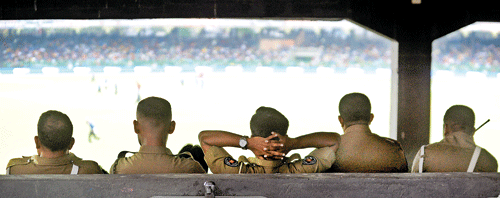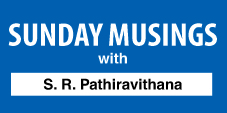The worst crisis to befall Sri Lanka’s cricket history
View(s): With the British army overrunning the last Sinhala Kingdom in 1815, it did not take long for the white sahibs to try their hands in coffee plantations. At the same time their came another birth of a different indulgence. It is said by 1823 some of the British planters had also tired their hands at cricket in the central hills of Kandy, purely as a recreation.
With the British army overrunning the last Sinhala Kingdom in 1815, it did not take long for the white sahibs to try their hands in coffee plantations. At the same time their came another birth of a different indulgence. It is said by 1823 some of the British planters had also tired their hands at cricket in the central hills of Kandy, purely as a recreation.In the formative years of cricket in Ceylon, the game was mainly played among the soldiers in the British army and it gradually got the attention of the missionaries and thus school like S. Thomas’ intensely began to get involved with it until they formed a union with the Colombo Academy and from that point onwards the game was never the same again.
The game began to grow and besides the Colombo Academy (Later Royal Collage) and S. Thomas’, other institutions such as Prince of Wales, St Sebastian’s, Trinity, St. Anthony’s, Ananda, Nalanda, St. Peter’s St. Joseph’s, Mahinda, Dharmaraja and Zahira came strongly on stage.
The first all Ceylonese cricket club in Sri Lanka was the Malay Cricket Club. Prior to that, the all British Colombo Cricket Club which came under the main crest of the Gymkhana Club played serious cricket. Gradually, the local club cricket system also took root, but, in general, the school and the club systems grew in tandem.
Nourished by this unplanned, but, matching system, the game of cricket grew like a huge tree. The schools had their own peculiarities while the clubs had their own intricacies and as a result Sri Lanka’s cricket also developed its own characteristics which were second to none, even in the big stage. The only drawback was that Ceylon was an island nation — tiny next to a giant like India or for that matter England.

At Dambulla, the Sri Lanka team bus was blocked by frustrated fans - Pix by Amila Gamage
So much so even prior to be recognised as a fully fledged Test nation, the game of cricket produced its own inimitable ‘stars’ such as S.S. Jayawickrema, F.C. de Saram, D.S. Jayasundera, Pat MCcarthy, M.K. Albert, Dr. C.H. Gunasekera, C.I. Gunasekera, M. Sathasivam, R. B. Wijesingha and P. Saravanamuttu and in the transition period cricketers in the calibre of Clive Inman, P.I. Peiris, Neil Chanmugam, Michael Tissera and Anura Tennekoon, H.I.K. Fernando, Stanley Jayasinghe, Gamani Goonasena, Anuruddha Polonowita, to name a few.
The first debacle
After ascertaining the cricket worthiness of the Ceylonese, the MCC in 1966 earmarked a tour of England for 1968. The Ceylon team was to play against 12 counties, two universities, MCC, Scotland and Ireland. In all it was to be a two month tour that would have taken them through 15 first class three-day games plus some minor county assignments.
The counties that were on the card were – Kent, Sussex, Worcestershire, Glamorgan, Leicestershire, Derbyshire, Lancashire, Surrey and Warwickshire.
However, two schools of thought emerged as to the composition of the team. One wanted the real Lankans who toil hard on their own soil to be in the team while the others advocated the inclusion of cricketers with experience in English conditions – Gamini Goonasena, Clive Inman (Leicestershire), Dan Piachaud (Oxford), Vijaya Malalasekera and Mano Ponniah (Cambridge). Then even in parliament, there were debates about who was going to finance a gigantic commitment of this nature with some parliamentarians against it. The task was to purchase thirteen air tickets to England.
Then during preparations (which were still going on) there came the back stabbing. The then national captain Michael Tissera who led the country in two overseas Test victories (unofficial) against Pakistan (1964/65) and India (1964/65) was replaced by H.I.K. Fernando for the match against Joe Lister’s Xl without a proper reason. Then during the selections – three selectors put their names into the tour squad. Thus one thing led to the other and Sri Lanka’s maiden tour to England was aborted, in 1968.
 Later on Michael Tissera confided in me saying “By losing that opportunity Sri Lanka Cricket went back by a few years. Had we made that tour we could have been able to push for full status a bit earlier”.
Later on Michael Tissera confided in me saying “By losing that opportunity Sri Lanka Cricket went back by a few years. Had we made that tour we could have been able to push for full status a bit earlier”.
Just prior to Sri Lanka gaining Test status, Sri Lanka playing under Bandula Warnapura against Australia in 1981, enjoyed a dream run. In the unofficial four-day Test, the visitors were out for under 200 runs in both innings at the Oval. Australia scored 124 and 178 in the two innings failing against the bowling of spinners Ajith de Silva and Lalith Kaluperuma while Sri Lanka in their turn scored 177 all out.
The fledgling Lankans beat the Australians in the ODI, after skipper Warnapura (106) and Sidath Wettimuny (46) owning the innings put on 170 runs in reply to Australia’s score of 188. The Lankans won the match by six wickets.
Test status
After that magnificent show, Sri Lanka on July 22, 1981 gained full membership of the ICC, thanks to a heroic effort by the then minister Gamini Dissanayake, who was also the Cricket Board head. The office bearers of the first executive committee that heralded the Sri Lanka’s Test era read as: President-Gamini Dissanayake, Vice President-T. Murugesar, Secretary-Nisal Senaratne, Treasurer-Nuski Mohamed, Assistant Secretary-Michael de Zoysa and Assistant Treasurer-Bertram Perera.
Sri Lanka played their official Test match against England from February 17-22 at the P. Saravanamuttu Stadium, Colombo.
Though the Lankans lost the inaugural Test in 1982, they were not embarrassed and, in reality, at certain points the Lankans held sway. At the same time it was the game where Sri Lanka discovered the talent of Arjuna Ranatunga.

The situation worsened when the fans could not digest the proceedings anymore at Pallekele, when bottles were thrown into the ground
The second debacle
Whatever strength that the Lankan cricket gained after the inaugural Test was nullified the same October when a rebel team calling themselves Arosa Sri Lanka made a tour of South Africa – a nation ruled by a reprehensible apartheid system and shunned by the international cricketing community.
The repercussions were severe. The Rest of the cricketing world looked agape and condemned the treacherous act, and none of the rebel cricketers represented the country again.
Later on, after serving a ban the most of the rebel cricketers got back into active cricket in an administrative capacity once again.
The despicable
In 1984 Sri Lanka taking on New Zealand faced their first crowd unrest when the Lankan slid to a sudden second inning collapse in Kandy. The first inning was uneventful. New Zealand scored 276 all out and in reply the Lankans made 215 all out.
In the second inning New Zealand declared their inning at 201 for 8 leaving the home team a target of 263 to win. Yet, the Lankans slid to an embarrassing 97 all with left arm spinner Stephen Boock (5 for 28) and Richard Hadlee (4 for ![]() making short work on the Lankan batsmen. Lankans crashed to a 165 run defeat, but, the fans in Kandy did not take it up well.
making short work on the Lankan batsmen. Lankans crashed to a 165 run defeat, but, the fans in Kandy did not take it up well.
This followed a crowed unrest, but, it was also learned that there were some interested parties who instigated the crowd unrest.
The rise
Sri Lanka won its first Test match under Duleep Mendis on September 11, 1985 against India, recording a 149 runs victory at P. Saravanamuttu Stadium, Colombo. Sri Lanka also won the three-match Test series, 1-0 and Kapil Dev led the Indian team.
Due to more than one reason the Lankans were not regulars on the international scene like now. But, kept improving with almost every opportunity they got.
The pinnacle of this rise is the ICC World Cup title under Arjuna Ranatunga, who made his Test debut at the inaugural Test match.
Change of heads and the World Cup debacle

Security Personnel far outnumbered the handful of loyal fans at the RPICS
Everyone knows how the changes occurred at the BCCSL with the ICC World Champions tag. Upali Dharmadasa replaced Ana Punchihewa who was at the helm when Sri Lankan won the title in 1996. Then in 1998 cricket’s heir apparent Thilanga Sumathipala took over the hot seat and prepared the Lankans going in for their title defence in 1999 in England.
Since the Word Cup win, Sri Lanka had very few identified by-lateral ODI series. Going by the number they were vs New Zealand in 1996/97, West Indies in 1997, India in 97 and 97/98 and Zimbabwe in 97/98.
At that point the Lankan management changed its focus and played a large of organised series which played for a Trophy and Prize money – this was one of the charges that were brought upon the Lankan cricket administrators after their dismal show at the World Cup defence where Sri Lanka was eliminated in the first round itself and Thilanga Sumathipala was removed from his cricket hot seat. Between the latter part of the 1997 to 1999 title defence Sri Lanka was involved in seven organised series that involved prize money, but, not a single by-lateral series prior to the 1999 World Championship in England.
Then the Interim Committee which took over the custody of cricket in 2000, not only changed the cricket board head, but, also dropped captain Arjuna Ranatunga, vice captain Aravinda de Silva and a few others and handed the mantle over to Sanath Jayasuriya who ran up a record number wins including the first Test victory against Australia at home.
The present crisis
The present crisis is not a direct result of losing the services Mahela Jayawardena, Kumar Sangakkara and T.M. Dilshan. This is a crisis that has been brought upon us by Sri Lanka losing its focus. There are batsmen who score the odd hundred or bowlers who bag the odd five wickets, but, they are not attuned mentally to play serious cricket due to what is happening in the administrative circle.
 They had a golden opportunity to build upon. They had a very encouraging three-nil victory against Australia, but the administration’s blurred vision was putting severe stress upon players such as Angelo Mathews and Dinesh Chandimal. At the same time the manner in which they handled the Graham Ford issue was completely unjustified.
They had a golden opportunity to build upon. They had a very encouraging three-nil victory against Australia, but the administration’s blurred vision was putting severe stress upon players such as Angelo Mathews and Dinesh Chandimal. At the same time the manner in which they handled the Graham Ford issue was completely unjustified.
When one puts stress upon a fledgling composition it does not have the proper foundation in this manner, the possibility of it caving in is there and exactly that is what has happened.
Now unlike any other, the cricket loving public has got emotionally stirred-up. First they tried to voice their opinion at Independence square, got vociferous in Dambulla and violent at Pallekelle. Finally, at the Premadasa Stadium they stayed away, there were hardly 5000 people at a game where 30,000 should have been — mind you for the match against India. To make things worse Sri Lanka slid to their worst defeat at home.
What I see is the biggest debacle in cricket in our 200-year involvement of the game.Who will take the blame?


